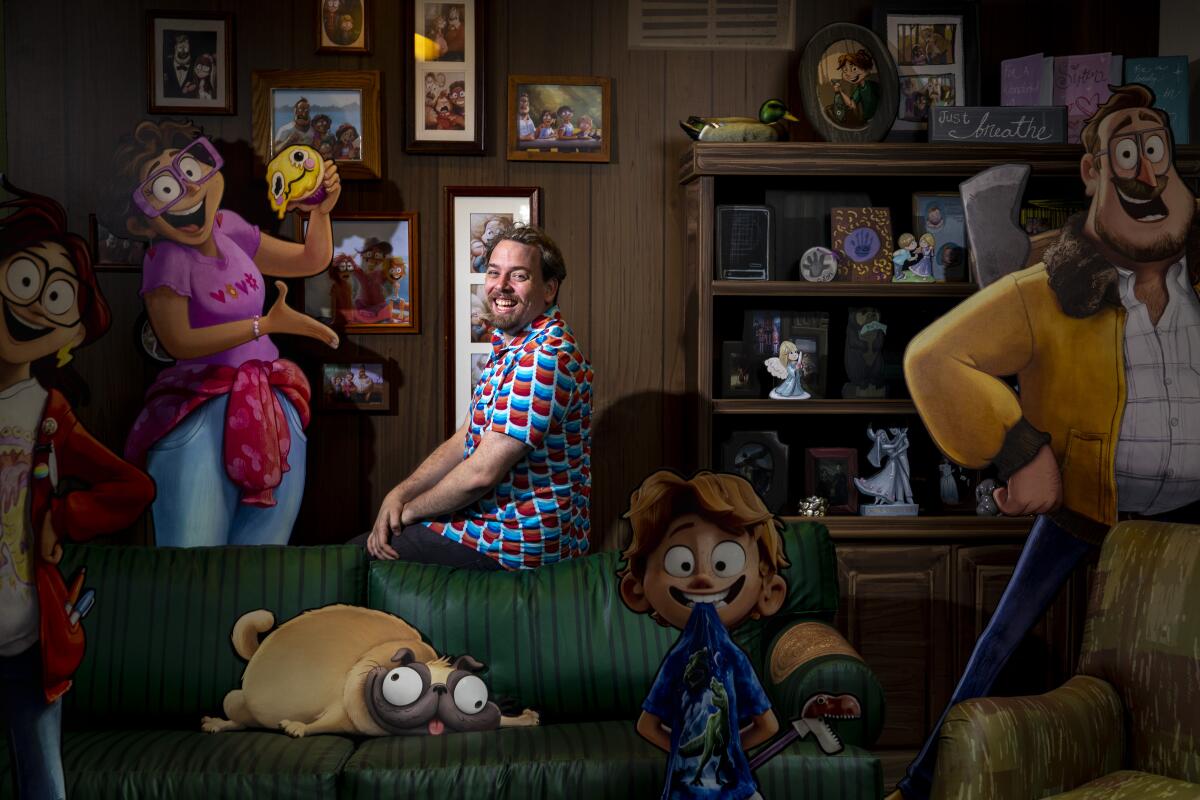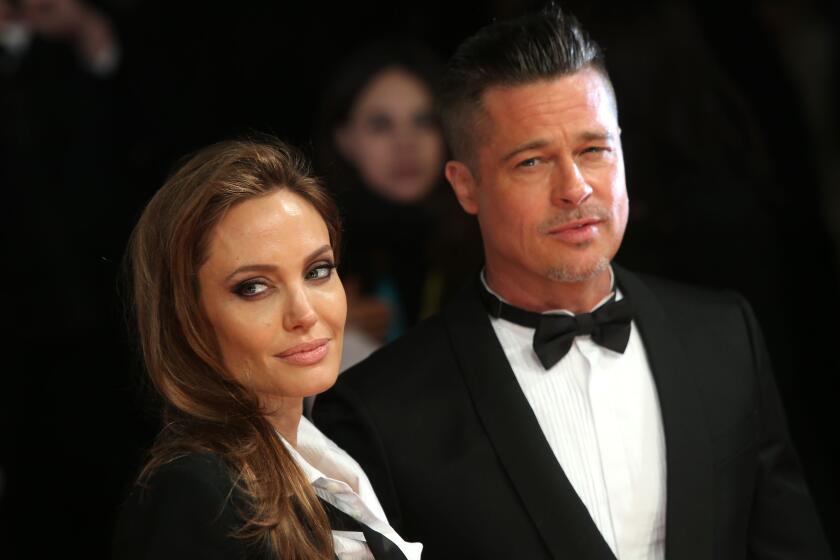In evil-robot animated comedy ‘Mitchells vs. the Machines,’ not all tech is bad. Here’s why

- Share via
Katie Mitchell just wants to get to film school. Unfortunately, her dad decides a cross-country road trip with the whole family is the best way to see her off to college and cancels her flight to Los Angeles.
Then a smartphone assistant initiates a machine uprising.
“I tried to take the thing that I cared the most about in the world, which is my crazy family, and mix it with the thing that I cared about when I was a little kid, which was killer robots,” said director Mike Rianda of his debut feature, “The Mitchells vs. the Machines,” in a recent video call.
Written by Rianda and Jeff Rowe, who previously were writers on the Disney TV series “Gravity Falls,” the action-packed animated comedy, out now on Netflix, sees the Mitchells become humanity’s last hope after the latest smartphone upgrade leads to AI deciding human beings are obsolete.
“As an adult, I’m super interested in the fact that robots and AI are starting to do a lot of the things that humans can do,” said Rianda. “In a world where AI and robots can do what we can do, what is valuable about humanity and the human race? It’s those relationships and those collaborations between people that make us great.”
In addition to Katie (Abbi Jacobson), the aspiring filmmaker, the Mitchell family includes her dinosaur-obsessed younger brother, Aaron (Rianda), super-mom Linda (Maya Rudolph) and dad Rick (Danny McBride), who is not much for screen time. It’s their relatable family dynamic that carries the emotional arc of the film.
The dysfunctional family road-trip comedy gets a tech-infused makeover in ‘The Mitchells vs. the Machines,’ a Netflix animated feature.
The peril comes in the form of technology when robots, appliances and even toys turn against humans. But the film’s message is not as simple as “phones are bad.”
“From the beginning, we were trying to have a nuanced take on our relationship with technology,” said producer Chris Miller. “We wanted to make sure that the story reflected that Katie was using all this technology for good and cool and fun things, and that was something to be celebrated.”
It’s through technology that Katie is able to make her films, and it also helps her connect with like-minded people: her future classmates.
Similarly, Rianda credits technology with helping him realize there is a future in creative pursuits.
“I found out that I could be a cartoonist by going onto chat rooms, and I met real cartoonists,” said Rianda. “I met some of my heroes on there.… Seeing that other people could do it online sort of convinced me that maybe I could do it. So that’s another way in which we didn’t want to cast technology in this horrible light, because we’ve all seen for ourselves that you can do amazing things as well.”
According to Miller, technology’s ability, in some cases, to help forge connections and bring people closer while, in other cases, preventing people from having genuine interactions was a theme that was always present in the movie. But as the pandemic forced more people to rely on technology and pushed most interactions into the virtual realm for safety, the filmmakers felt they needed to be even more deliberate in making that point clear.
“A lot of the things that Mike had already put in there just happened to ring extra true now because we’ve lived through a sort of apocalyptic scenario in which tech is a huge part of our survival,” said Miller. “We [also] all felt like we should make sure that we represent some of the newer reflections that we’ve all been having this past year.”
For Phil Lord, who also served as a producer on the film, what stood out was how the story evolved.
In feature animation, “your focus is much more on the emotional storytelling,” said Lord. “And you are living and dying by whether or not the audience is engaged in what those characters are thinking and feeling.”
Lord recalled how earlier in the production he had warned Rianda that he and Miller’s involvement meant they were going to “make the movie a lot worse for like a year.”
“Spider-Man: Into the Spider-Verse” was something of a creative dare when filmmakers Phil Lord and Chris Miller first pitched their idea to Sony executives in 2014, the same year their animated smash “The Lego Movie” put an unexpected CG animated twist on the classic toy bricks.
“The emotional architecture of this movie [needed to] grow up a little bit,” said Lord. That “means we were going to have to take this wonderful experience and pull it apart and put it back together again. Not everybody is up for that.” Rianda was.
It “went from being a movie about people trying to stop fighting to being a movie about people trying to get along,” said Lord. “I think that’s a very subtle distinction. But it really is meaningful. And it’s beautiful to watch. I find it really moving.”
In addition to its resonant themes, “The Mitchells vs. the Machines” stands out for its creative visual approach. The stylized animation mixes 2-D and 3-D elements that make the CGI appear more like a mixed-media film, complete with DIY embellishments such as floating hearts and doodles.
“I think in a lot of ways the movie kind of feels like a bunch of film students sort of hijacked a big-budget animated movie,” said Rianda. “We had all these ideas, [but] they wouldn’t have stuck if they didn’t actually reflect the characters. And I think because Katie is a filmmaker, having it feel like she’s editing the movie and stuff made you feel closer to her as a character and made you feel like, ‘Oh, this whole movie is from her perspective.’”
Miller explained that Rianda and his team took some of the new animation tools developed for “Spider-Man: Into the Spider-Verse,” the 2018 Sony Pictures Animation film also produced by Miller and Lord, and “took it to a whole new level.”
“Mike took [these tools] and adapted them and turned them into something that can make something feel completely handmade, hand-painted and analog, even though it was made mostly by computers,” said Miller, who praised Rianda’s team for being able to channel some energy and habits more associated with TV animation to achieve uniquely charming results.
For Rianda, the goal was always to reflect the Mitchells lovingly, their individuality as well as their flaws. And he credits production designer Lindsey Olivares, visual effects supervisor Michael Lasker and their teams for capturing that familial compassion and love.
“I think that the team did just an amazing job at making sure that the characters’ humanities and flaws are apparent in every frame.”
More to Read
Only good movies
Get the Indie Focus newsletter, Mark Olsen's weekly guide to the world of cinema.
You may occasionally receive promotional content from the Los Angeles Times.











